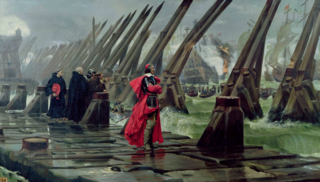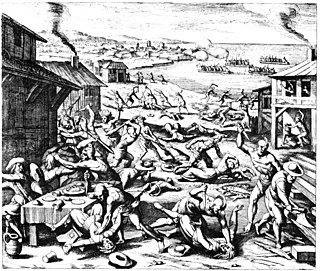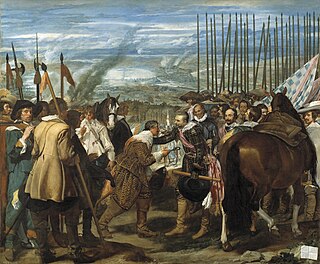 W
WThe First Anglo-Dutch War, or simply the First Dutch War, was a conflict fought entirely at sea between the navies of the Commonwealth of England and the United Provinces of the Netherlands. It was largely caused by disputes over trade, and English historians also emphasise political issues. The war began with English attacks on Dutch merchant shipping, but expanded to vast fleet actions. Although the English Navy won most of these battles, they only controlled the seas around England, and after the tactical English victory at Scheveningen, the Dutch used smaller warships and privateers to capture numerous English merchant ships. Therefore, by November 1653 Cromwell was willing to make peace, provided the House of Orange was excluded from the office of Stadtholder. Cromwell also attempted to protect English trade against Dutch competition by creating a monopoly on trade between England and her colonies. It was the first of the four Anglo-Dutch Wars.
 W
WThe Second Anglo-Dutch War or the Second Dutch War was a conflict between England and the Dutch Republic partly for control over the seas and trade routes, where England tried to end the Dutch domination of world trade during a period of intense European commercial rivalry, but also as a result of political tensions. After initial English successes, the war ended in a Dutch victory. It was the second of a series of naval wars fought between the English and the Dutch in the 17th and 18th centuries.
 W
WThe Anglo-French War was a military conflict fought between the Kingdom of France and the Kingdom of England between 1627 and 1629. It mainly involved actions at sea. The centrepiece of the conflict was the siege of La Rochelle (1627–28), in which the English crown supported the French Huguenots in their fight against the French royal forces of Louis XIII of France. La Rochelle had become the stronghold of the French Huguenots, under its own governance. It was the centre of Huguenot seapower and the strongest centre of resistance against the central government. The English also launched a campaign against France's new colony in North America which led to much of the territory including Quebec being seized.
 W
WThe Anglo–Powhatan Wars were three wars fought between settlers of the Virginia Colony and Algonquin Indians of the Powhatan Confederacy in the early seventeenth century. The first war started in 1610 and ended in a peace settlement in 1614. The second war lasted from 1622 to 1626. The third war lasted from 1644 until 1646 and ended when Opechancanough was captured and killed. That war resulted in a defined boundary between the Indians and colonial lands that could only be crossed for official business with a special pass. This situation lasted until 1677 and the Treaty of Middle Plantation which established Indian reservations following Bacon's Rebellion.
 W
WThe Anglo–Spanish War was a war fought by Spain against the Kingdom of England and the United Provinces from 1625 to 1630. The conflict formed part of the Eighty Years' War and the Thirty Years' War.
 W
WThe Anglo-Spanish War was a conflict between the English Protectorate under Oliver Cromwell and Spain, between 1654 and 1660. It was caused by commercial rivalry. Each side attacked the other's commercial and colonial interests in various ways such as privateering and naval expeditions. In 1655, an English amphibious expedition invaded Spanish territory in the Caribbean. In 1657, England formed an alliance with France, merging the Anglo–Spanish war with the larger Franco-Spanish War resulting in major land actions that took place in the Spanish Netherlands.
 W
WThe Cádiz expedition of 1625 was a naval expedition against Spain by English and Dutch forces. The plan was put forward because after the Dissolution of the Parliament of 1625, the Duke of Buckingham, Lord High Admiral, wanted to undertake an expedition that would match the exploits of the raiders of the Elizabethan era and in doing so, would return respect to the country and its people after the political stress of the preceding years.
 W
WThe Clubmen of Dorset and Wiltshire were a paramilitary unit formed in late 1644 or early 1645, during the English Civil War, in the Dorset and Wiltshire region. As with other groups of Clubmen, they were formed for the purpose of self-protection from the deprivations of both the Parliamentarians and the Royalists, with their goal being the cessation of all hostilities.
 W
WThe English Civil War (1642–1651) was a series of civil wars and political machinations between Parliamentarians ("Roundheads") and Royalists ("Cavaliers"), mainly over the manner of England's governance and issues of religious freedom. It was part of the wider Wars of the Three Kingdoms. The first (1642–1646) and second (1648–1649) wars pitted the supporters of King Charles I against the supporters of the Long Parliament, while the third (1649–1651) saw fighting between supporters of King Charles II and supporters of the Rump Parliament. The wars also involved the Scottish Covenanters and Irish Confederates. The war ended with Parliamentarian victory at the Battle of Worcester on 3 September 1651.
 W
WThe English expedition to Portugal also known as the British Brigade in Portugal was a brigade raised during the reign of King Charles II for service in Portugal during the ongoing Portuguese Restoration War against Spain in August 1662. The brigade, many of which were veterans of the English Civil Wars and the Dutch Revolt, then fought in all the major battles and skirmishes under the command of Frederick Schomberg, 1st Duke of Schomberg and remained in Portugal until the end of the war being subsequently disbanded by mid 1668. The brigade under Schomberg's leadership, proved a decisive factor in winning back Portugal's independence.
 W
WHolmes's Bonfire was a raid on the Vlie estuary in the Netherlands, executed by the English Fleet during the Second Anglo-Dutch War on 19 and 20 August 1666 New Style. The attack, named after the commander of the landing force, Rear-Admiral Robert Holmes, was successful in destroying by fire a large merchant fleet of 140 ships. During the same action, the town of West-Terschelling was burnt down, which caused outrage in the Dutch Republic.
 W
WKing William's War was the North American theater of the Nine Years' War (1688–1697), also known as the War of the Grand Alliance or the War of the League of Augsburg. It was the first of six colonial wars fought between New France and New England along with their respective Native allies before France ceded its remaining mainland territories in North America east of the Mississippi River in 1763.
 W
WThe Battle off Lizard Point was a naval action which took place on 18 February 1637 off the coast of Cornwall, England, during the Eighty Years' War. The Spanish admiral Miguel de Horna, commander of the Armada of Flanders, intercepted an important Anglo-Dutch merchant convoy of 44 vessels escorted by six warships, destroying or capturing 20 of them, and returned safely to his base in Dunkirk.
 W
WThe Nine Years' War (1688–1697), often called the War of the Grand Alliance or the War of the League of Augsburg, was a conflict between France and a European coalition which mainly included the Holy Roman Empire, the Dutch Republic, England, Spain, Savoy and Portugal. It was fought in Europe and the surrounding seas, in North America, and in India. It is sometimes considered the first global war. The conflict encompassed the Williamite war in Ireland and Jacobite risings in Scotland, where William III and James II struggled for control of England and Ireland, and a campaign in colonial North America between French and English settlers and their respective Indigenous allies.
 W
WThe Portuguese Restoration War was the war between Portugal and Spain that began with the Portuguese revolution of 1640 and ended with the Treaty of Lisbon in 1668, bringing a formal end to the Iberian Union. The period from 1640 to 1668 was marked by periodic skirmishes between Portugal and Spain, as well as short episodes of more serious warfare, much of it occasioned by Spanish and Portuguese entanglements with non-Iberian powers. Spain was involved in the Thirty Years' War until 1648 and the Franco–Spanish War until 1659, while Portugal was involved in the Dutch–Portuguese War until 1663.
 W
WThe siege of 's-Hertogenbosch also known as the siege of Bois-Le-Duc was an action in 1629, during the Eighty Years' War and the Anglo–Spanish War in which a Dutch and English army captured the city of 's-Hertogenbosch. The city had been loyal to the King of Spain since 1579 and was part of the Spanish Netherlands.
 W
WThe siege of 's-Hertogenbosch of 1601 (Sitio de Bolduque de 1601 in Spanish) was an unsuccessful Dutch attempt led by Prince Maurice of Nassau and William Louis of Nassau-Dillenburg to capture the city of 's-Hertogenbosch, North Brabant, Spanish Netherlands, garrisoned by about 1,500–2,000 Spanish soldiers led by Governor Anthonie Schetz, Baron of Grobbendonck, between 1 and 27 November 1601, during the Eighty Years' War and the Anglo-Spanish War (1585–1604), in the context of the long and bloodiest siege of Ostend.
 W
WThe siege of Breda of 1624–25 occurred during the Eighty Years' War. The siege resulted in Breda, a Dutch fortified city, falling into the control of the Army of Flanders.
 W
WThe siege of Grol in 1627 was a battle between the Army of the Dutch Republic commanded by Frederick Henry, Prince of Orange and the Spanish controlled fortified city of Grol, during the Eighty Years War and the Anglo–Spanish War in 1627. The Spanish army led by Hendrik van den Bergh came to relieve Grol, but it came too late. The siege lasted from 20 July until 19 August 1627, resulting in the surrender of the city to the army of the United Provinces.
 W
WThe Thirty Years' War was a conflict fought largely within the Holy Roman Empire from 1618 to 1648. Considered one of the most destructive wars in European history, estimates of military and civilian deaths range from 4.5 to 8 million, while up to 60% of the population may have died in some areas of Germany. Related conflicts include the Eighty Years' War, the War of the Mantuan Succession, the Franco-Spanish War, and the Portuguese Restoration War.
 W
WThe Western Design is the term commonly used for an English expedition against the Spanish West Indies during the 1654 to 1660 Anglo-Spanish War.